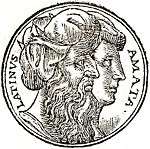Latinus
Latinus (Latin: Latinus; Ancient Greek: Λατῖνος) was a figure in both Greek and Roman mythology. He is often associated with the heroes of the Trojan War, namely Odysseus and Aeneas. Although his appearance in the Aeneid is irreconcilable with his appearance in Greek mythology, the two pictures are not so different that he cannot be seen as one character.

.jpg)
Greek mythology
In Hesiod's Theogony,[1] Latinus was the son of Odysseus and Circe who ruled the Tyrsenoi, presumably the Etruscans, with his brothers Ardeas and Telegonus. Latinus is also referred to, by much later authors, as the son of Pandora II and brother of Graecus,[2] although according to Hesiod, Graecus had three brothers, Hellen, Magnetas, and Macedon, with the first being the father of Doros, Xuthos, and Aeolus.
Roman mythology
In later Roman mythology (notably Virgil's Aeneid), Latinus, or Lavinius, was a king of the Latins. He is sometimes described as the son of Faunus and Marica, and father of Lavinia with his wife, Amata. He hosted Aeneas's army of exiled Trojans and offered them the chance to reorganize their life in Latium. His wife Amata wished his daughter Lavinia to be betrothed to Turnus, king of the Rutuli, but Faunus and the gods insisted that he give her instead to Aeneas;[3] consequently, Turnus declared war on Aeneas and was killed two weeks into the conflict. Ascanius, the son of Aeneas, later founded Alba Longa and was the first in a long series of kings leading to Romulus and Remus, the founders of Rome.
This version is not compatible with the Greek one: the Trojan War had ended only eight years earlier, and Odysseus only met Circe a couple of months later, so any son of the pair could only be seven years old, whereas the Roman Latinus had an adult daughter by then.
See also
- Latium
- Latin kings of Alba Longa
- Aborigines (mythology)
References
- Lines 1011–1016.
- Parada, Carlos. Greek Mythology Link. "Zeus" (1997).
- Robin Hard; H. J. Rose (2004). The Routledge Handbook of Greek Mythology: Based on H.J. Rose's "Handbook of Greek Mythology". Psychology Press. pp. 590–. ISBN 978-0-415-18636-0.
Sources
| Wikisource has original text related to this article: |
| Legendary titles | ||
|---|---|---|
| New creation | king of the Aborigines 1217-1180 BC |
Succeeded by Aeneas |